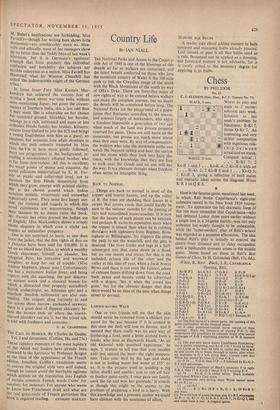Chess
BY PHILIDOR No. 23.
C. J. ALLISON (Hon. Men., B.C.F. Tourney No. 77) WHITE, 11 men.
mate in 2 moves:
solution next week. Solution to last week's problem by Neumann: B-Kt 7, threat Q-Kt 7. An interesting and very skilful composition with ingenious rela- ship between
actual and set mates.
Compare actual 1 . R-Kt 7; 2
Kt-B 3 and 1 Kt-K 4; 2 Kt-B 6 with set 1 . . . R-Kt 2; 2 Kt-B 6 and 1 . . . Kt-Q 5; 2 Kt-B 3, giving a reflection of both mates and thematic ideas across the diagonal White K R 1 to Q R 8.
Here is the famous game, mentioned last week, in which Red broke Capablanca's eight-year unbeaten record in the New York 1924 tourna- ment. To appreciate the full dramatic force of this one must remember that Capab lance—who had defeated Lasker three years earlier without a single loss in a 14-game match—was not only unbeaten but widely thought tb be unbeatable, while the 'hyper-modern' play of Reti's school was regarded as a senseless affectation. The idea behind Reti's play is initially to control the centre from distance and to delay occupation until a favourable moment arises in the middle game. Notes based on those in Rerti's Best Gaines of Chess, by H. Golombek (Bell, 17s. 6d.). While, R. RET1 Black, J. R. CAPABLANCA Opening, Reti.
! Kt-1C 113 Kt-K B 3 17 Q-B 3 KPxP
2 P-B 4 P-K Kt 3 18 P x P Kt(B 3)-Q 2 (t)
3 P-Q Kt 4 B-Kt 2 19 Q-Q 2 PxP
4 13-Kt 2 0-.0 20 BxP QxP 5 P-Kt 3 P-Kt 3 21 Bx13 K x 13 6 B-Kt 2 B-Kt 2 22 Q-Kt 2 eh! K-Kt
7 0-0 P-Q 3 (a) 23 R x p Q-B 4 8 P-Q 3 Q Kt-Q 2 24 Q R-Q R-R 2 9 Q Kt-Q 2 P-K 4 25 Kt-K 3 Q-R 4 (k) 10 Q-11 2 R-K 1 26 Kt-Q 41 (i) B x B 11 K R-Q 1 (b) P-Q R 4 27 K x13 Q-K 4 (i) 12 P-Q R 3 P-R 3 (c) 28 Kt-B 4 Q-Q Et 4 13 Kt-l3 1 P-B 4 ?(d) 29 Kt-B 6 R-B 2 14 P-Kt 5 Kt-B 1 (e) 30 Kt-K 3 Kt-K 4 15 P-K 3 0-13 2 31 R(Q 1)-Q 5 Resigns (k) 16 P-Q 41(f) B-KS.
(a) The first move of a centre pawn: the opening of this game confounded all the classical tenets. (b) A deep positional-tactical move typical of these openings. Black has intention of playing P-K 5; this undermines this possibility by ultimate threat after central exchanges of P-13 5 exploiting position of W R opposite B Q. (c) This and next move shows Capablanca floundering: text is merely weakening, and Kt-II I-K 3 would be better.
(d) Cause of his loss: he fails to realise that White will be able (move 16) to break through in centre, after which his weakness in Q 3 will prove fatal. Correct (new that White has moved Kt front Q 2) was P-K 5. (e) It' 14 ... P-Q 4; then 15 P x P followed by Kt-Q 2- B 4 with advantage. XI) Exposing weakness of Black's position; if in reply P-k 5, then 17 K Kt-Q 2 threat P-Q 5 winning K P. (g) 18 . . Kt-K 3; is rather better. Black probably overlooked White's 22nd move. 00 Apparently very strong, since White cannot move Kt on B 3 or ..
(I) ... can hci (/) 27 . . . R x Kt; 28 P x R, Q X R; 29 Kt-B 51 and wins.
(k) To avoid loss of queen he must play Kt-B 5 whentupea 32 R x Q, Kt x Q; 33 R-B 2, Kt—R 5; 34 Kt-Q 5, sad one other rook Is lost. A magical game.


































 Previous page
Previous page